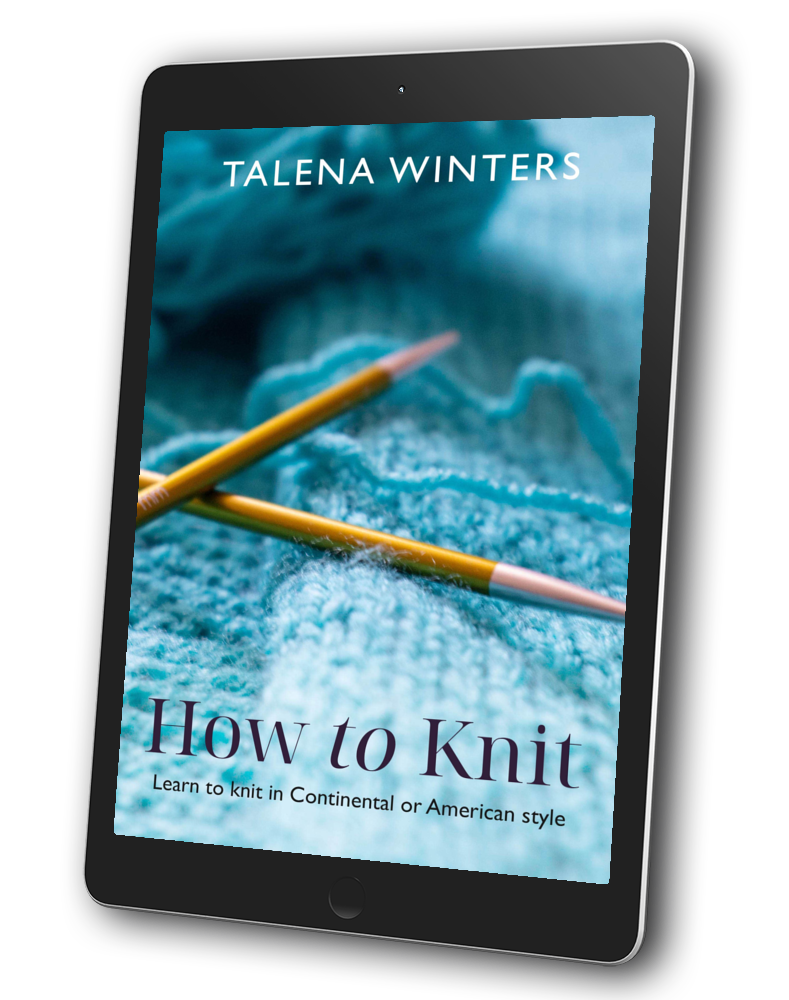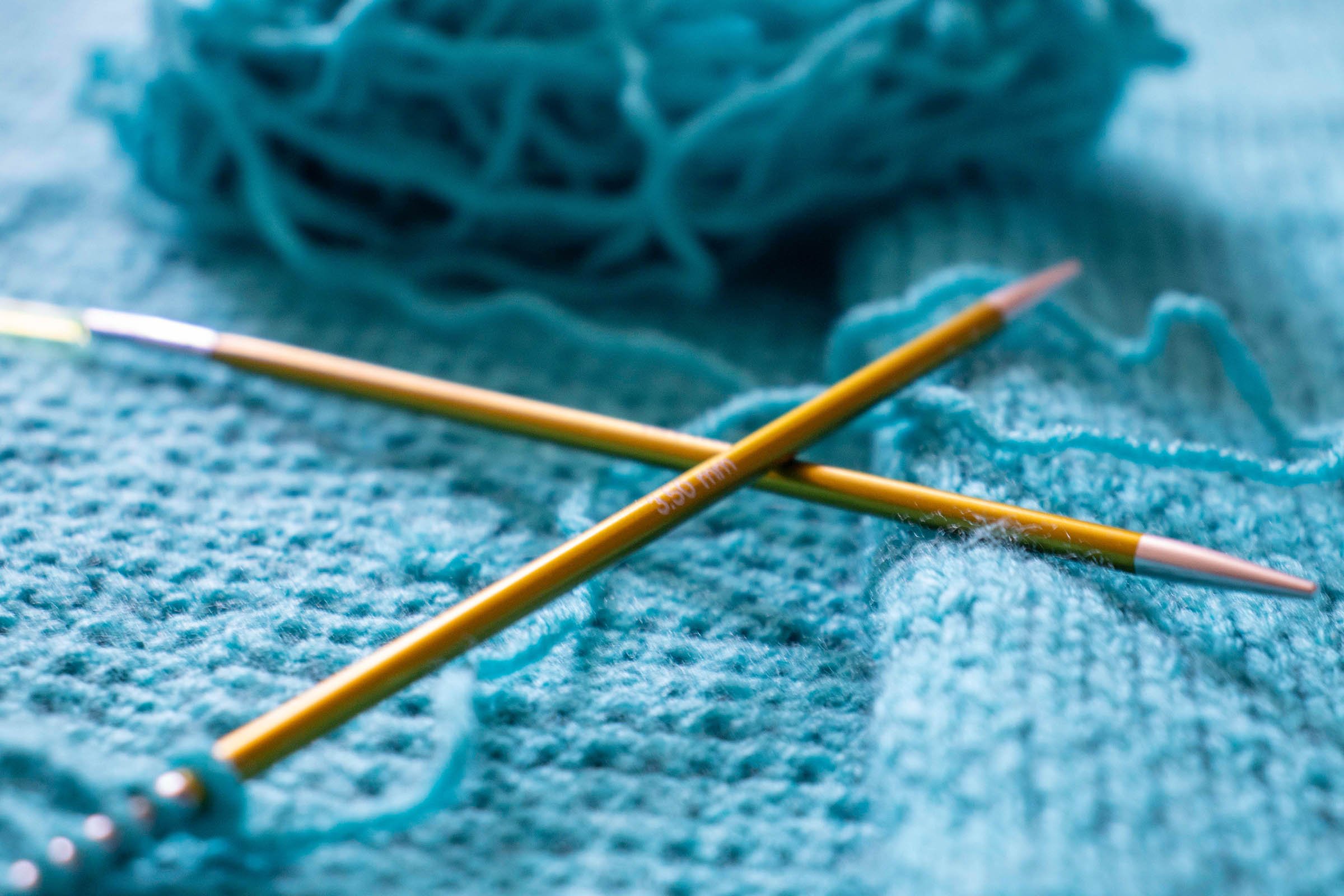
Choosing Yarn
How to choose the right yarn for your knitting project.
Adapted from How to Knit Lesson One. Get the complete tutorial at the link below.

How to choose the right yarn for your knitting project.
Adapted from How to Knit Lesson One. Get the complete tutorial at the link below.
So you’ve decided to giving knitting a shot. You might even know what you want to make. Which means you’re probably itching to dive in and start your project, but first, you need supplies. And before you even purchase yarn, there are a few things you should know.
Any knitting pattern you choose will call for a specific weight of yarn and a specific needle size. This combination is meant to give you what is known as gauge, or the same number of stitches and rows per square inch as the pattern designer. However, since knitters’ personal gauges can vary widely (and, as a beginner, yours is likely to be either too loose or too tight), it is always best to make a gauge swatch before beginning a pattern.
The Building Blocks Cowl & Hood (which was designed as a beginner teaching project to accompany the How to Knit tutorial) doesn’t require you to make a gauge swatch before you begin, because I know you just want to start making something! However, it’s still a good idea to do so, as it will allow you to gain a little experience on a practice project before making something you’ll want to wear.
In fact, in this tutorial, I’ll teach you how to make a gauge swatch as your first project. (We’ll bring it all together in “Making a Gauge Swatch”.)
But we've got a lot to cover before we get there, so let's get started. First things first (and the fun part): choosing your yarn.
Yarns come in different weight classifications, which are helpfully named to tell you how thick they probably are.
Yarn weights, from lightest to heaviest (or, if you prefer, skinniest to thickest), are:
Each yarn weight has a typical range of needle sizes that produce fabrics from dense to airy. The middle-of-the-road size is usually listed on yarn labels with the typical gauge you will get using that needle size.
For instance, worsted-weight yarn is usually knit on needles in a size range between 4.5 and 5.5 mm, and is frequently paired with 5.0 mm needles—a good size to create flexible but sturdy fabric, so that’s what the gauge on the label is given in. But for bulky-weight yarn such as the Building Blocks Cowl & Hood pattern uses, the middle-of-the-road needle size is 6.0 mm.
For more information about which needle size goes best with what yarn weight and average gauges, refer to the Craft Yarn Council’s page about it.
Yarn weight is often denoted on labels using a symbol similar to the Bulky one shown below—but be aware that the weight classification alone isn’t enough to determine if the yarn is right for your project. Some weights include a surprising range of densities and thicknesses which affect gauge a great deal. Read on to learn what other factors to consider when choosing yarn.
(Read more about needles, including needle size systems, tips about the different styles of knitting needles, and what each kind is best for in the “Choosing Needles” tutorial.)
Standardized yarn weight label.
Yarns are made in different ways, and each construction type gives the yarn different properties, making them suitable for different types of projects.
For your first several projects, choose a plied yarn (which means it’s made of several thinner cords twisted together) that is well-structured, not fuzzy, bubbly, hairy, or fancy in any way. The colour should not be too dark, as dark colours make it difficult to see what your yarn is doing and therefore harder to fix inevitable mistakes.
In addition, smooth, structured yarn gives good stitch definition, which means that the textures created by alternating your knit and purl stitches (as in the Building Blocks pattern) or knitting stitches in different orders (as in cables) can take centre stage.
Fancy novelty yarns that are hairy, uneven, fuzzy, flat, or other unusual yarn types are best for projects that use mostly stockinette stitch (created when you knit one direction and purl the other for back-and-forth knitting or knit every round for circular knitting), and sometimes garter stitch (knit both ways for back-and-forth knitting). Novelty yarns can also make wonderful trims or interest yarns when worked alternately with other types of yarn textures. Some, such as eyelash yarns (ones that appear hairy) work up best while being held double with another “plain” yarn.
As I already mentioned, within each yarn weight there can still be a great deal of variance for gauge. If you’re substituting yarns, make sure the length of the yarn per weight of the skein (e.g. 101 metres per 50 grams) matches the recommended yarn as closely as possible, while taking into account the differences fibre content can make (which we’ll talk about next).
A collection of skeins of bulky-weight yarn in different weights and fibre contents. These yarns all use plied construction.
Yarn comes in a wide range of different fibres and fibre blends, each of which has different properties. Knowing what those are will allow you to use them to your advantage. Not every fibre is suited for every project.
For instance, the best fibres for winter projects are wool or alpaca, as both are very warm (even when wet) and will wick moisture away from your skin.
Wool comes from sheep, and alpaca comes from, well, alpacas. Alpaca yarn has greater loft than wool, meaning it captures more air and can therefore be as warm as wool while being lighter weight. However, it’s usually more expensive.
Wool is also a wonderful fibre for felting, a process that interlocks the fibres into a thick, dense, extra-warm layer—but that also shrinks your project significantly. Wool roving (unspun wool) or other types of untreated wool yarn will need to be hand washed in cold water and laid flat to dry to avoid shrinking.
If you want something more washable while retaining the warmth and wicking benefits of wool, use Superwash wool, which has gone through a treatment process that allows it to resist shrinking when washed and that usually makes it softer.
Nylon (a synthetic fibre) or acetate (a semi-synthetic fibre made from tree cellulose) are sometimes blended with wool or alpaca fibres for strength and durability, while acrylic (a synthetic fibre made from plastic) is sometimes blended in for lustre or to reduce the cost.
Summer projects are best made with cotton, linen, or rayon from bamboo or other plant-based fibres, as they create very cool, breathable fabrics. However, these yarns are often inflexible, and the finished garments can tend to sag with wear. (Nothing a wash won’t fix, though.)
Linen, the second-strongest fibre after silk, is an amazing fibre made from flax that starts off feeling a little rough and scratchy but gets softer every time it’s washed. It’s very breathable, which makes it an excellent choice for summer projects. It is extremely inelastic and wrinkles easily, however, so it’s often blended with other fibres. It can also be hard on the hands.
Silk, which is made from unwinding the cocoons of silk worms, is the least elastic fibre, and one of the most expensive. It’s lightweight and lends a wonderful lustre to garments, but it doesn’t do well being washed in water and may require special care. All of these factors mean it is often reserved for treasured accessories like scarves or shawls, or blended in with other fibres.
Besides silk, luxury fibres like cashmere, angora, and various animal fur fibres are wonderful indulgences for special projects. Use them for small items like neck warmers or trims, or go all-out on a special sweater to treasure. Many of these fibres have a halo—a softening effect caused by fuzzy fibres blurring the lines—so are best used with plain stitch patterns (garter or stockinette).
Cashmere and mohair come from goats, and angora comes from rabbits. You can get other novelty yarns with fibres from a wide range of animals, including yaks, bison, possums, and even dogs! If you’re going to experiment with these, be sure to research their best uses and other special considerations first.
Many beginner knitters (myself included when I started out) begin with acrylic yarn because of availability and price. I would urge you to make the move to natural fibres as soon as you can afford to. While acrylic has its place, its lack of structure means your finished garments will lack the crispness you can achieve with natural fibres, and there’s not much you can do to fix oddities in the fabric with blocking (a finishing technique that covers many sins, which you can read more about in the tutorial on “Finishing”). Not only that, on the scale of warmth, it ranks near the bottom. (Though it’s much warmer than cotton, linen, and other plant-based fibres.)
However, if you’re knitting blankets, a garment that will need to be frequently washed or which may be likely to be lost (such as a small child’s mittens), or for someone who doesn’t react well to wool or other animal fibres, acrylic may be a good choice for you. Just be aware that you’re giving up some advantages in garment shaping and temperature regulation with this choice.
If you’re going to substitute yarns, be sure to choose a fibre type and construction whose properties are a good fit for the project you’re making. And because of the difference in weight for different fibres, make sure you purchase the minimum required yardage for your intended project. Fibre weights vary, but the yardage you’ll need in a given weight for your size is likely to be very similar.
While these pointers should get you started, there is a lot more to learn about yarn substitution. For now, do your best to match the yarn weight, yardage, and fibre content to the pattern recommendations in the project you’re making. As you gain experience, feel free to experiment with other fibre types.
Going into all the different types of yarn is beyond the scope of this tutorial, and whole books could be written on the subject. For further discussion about how to substitute yarn, read my tutorial about it.
Return to How to Knit index:

Hi! I’m Talena Winters (a.k.a. the Yarn Mermaid).
I started My Secret Wish Knitting in 2010 to empower and delight knitting heroes like you who want to elevate your knitting and make magic with yarn. When I’m not concocting new yarn potion recipes, I’m creating story magic as a fantasy and romance author and fiction editor (at talenawinters.com). I live with my family and pets in the Peace Country of northern Alberta, Canada, where sweater weather lasts at least nine months a year and my closest neighbours are bears and wood nymphs.
This website is a labour of love by a team of one (me!). If you found value here, please support the effort by purchasing a pattern. If you want more knitting magic, check out my community events and newsletter in the Knitting Circle. We’d love to have you!



